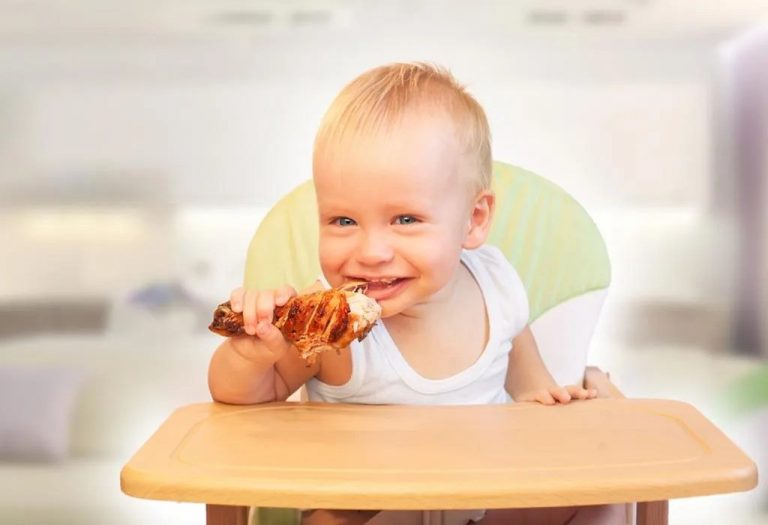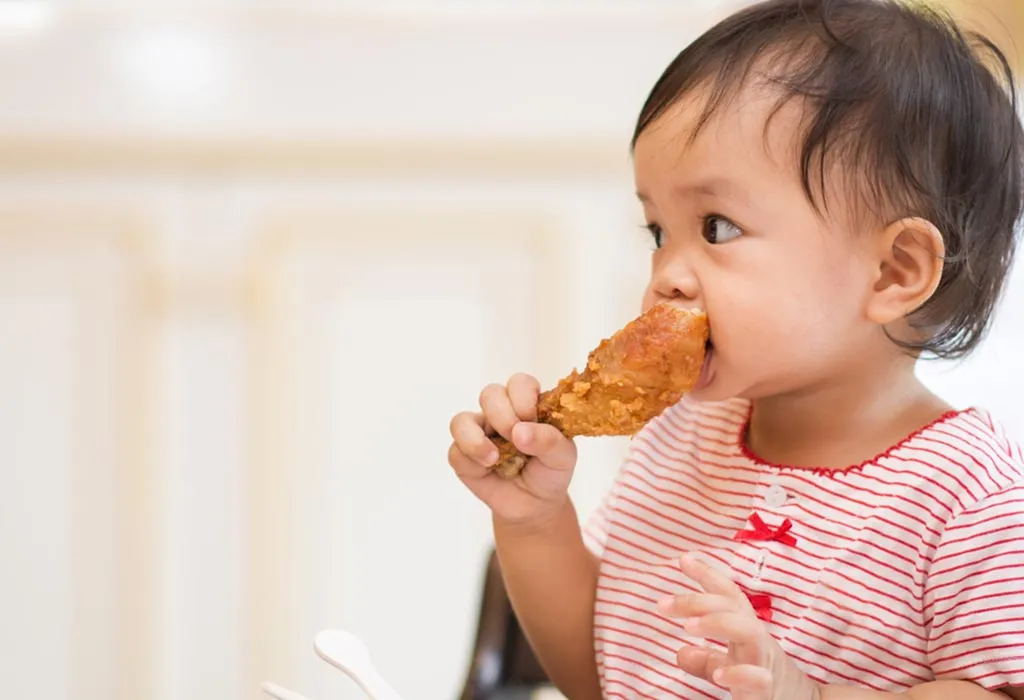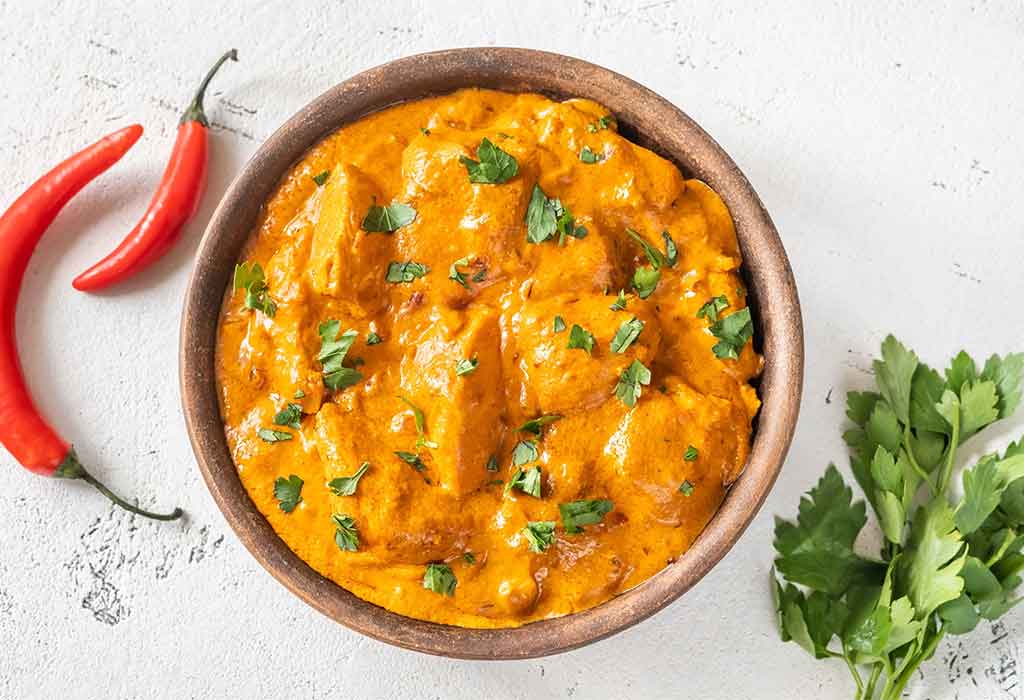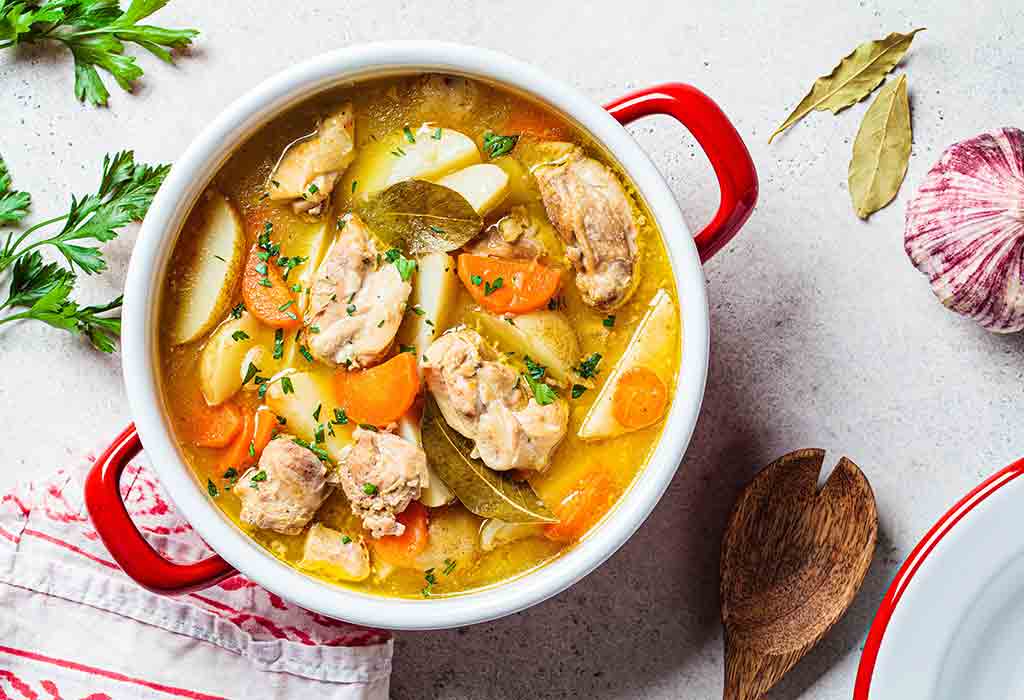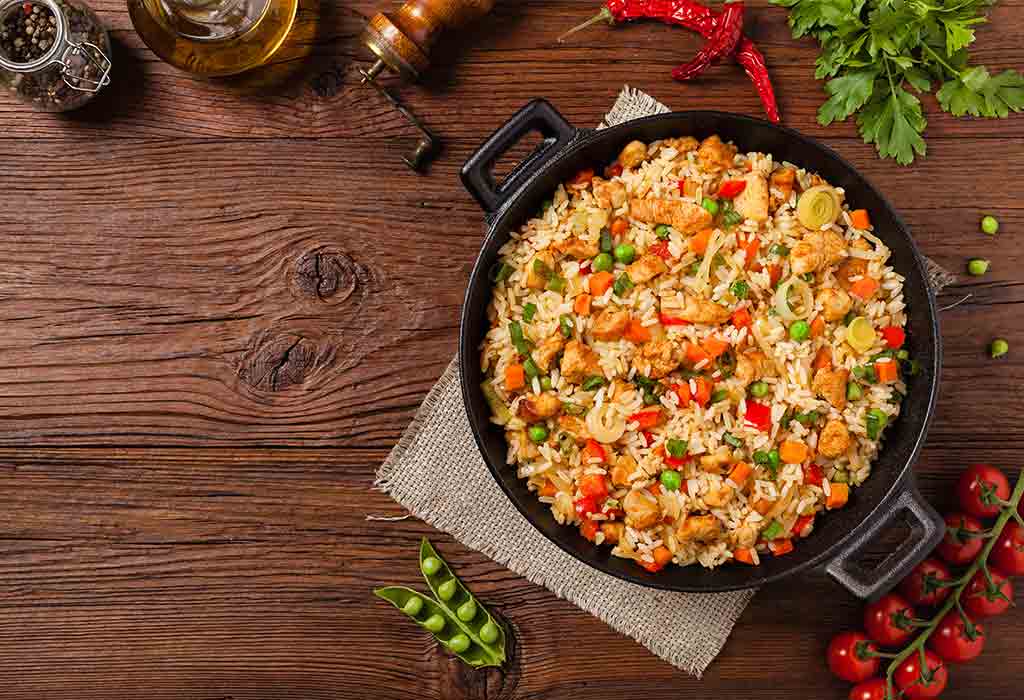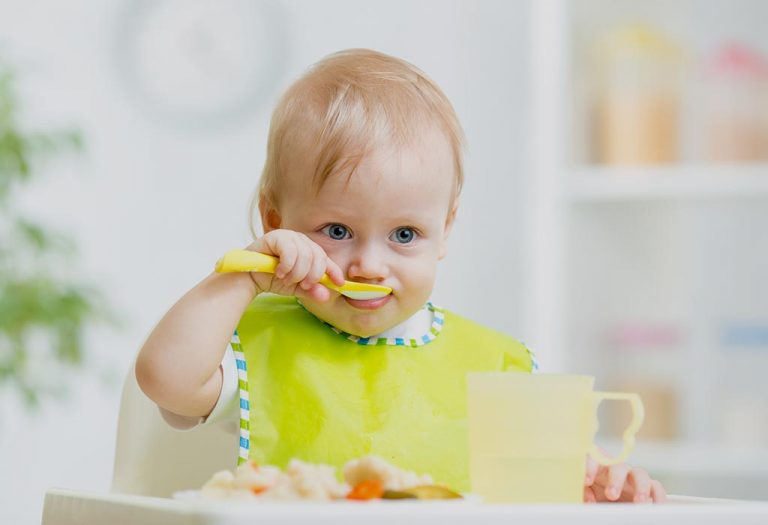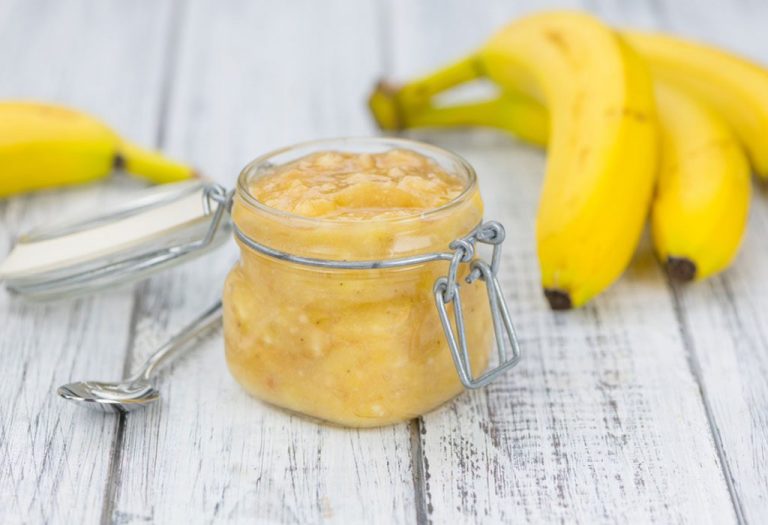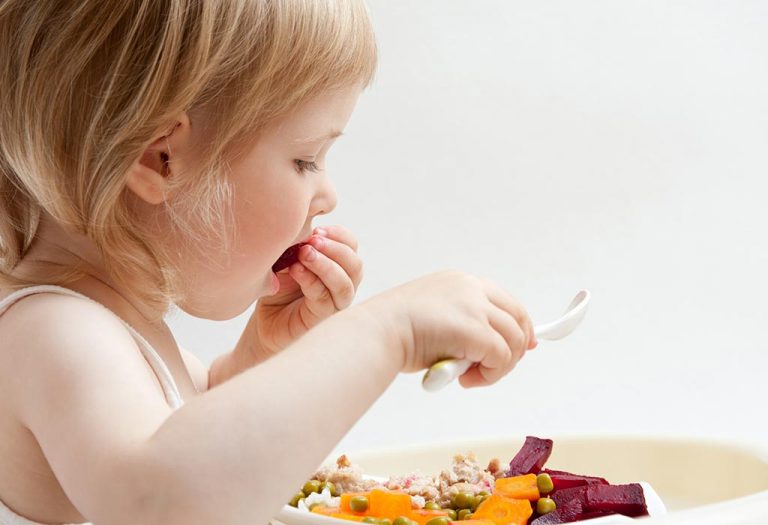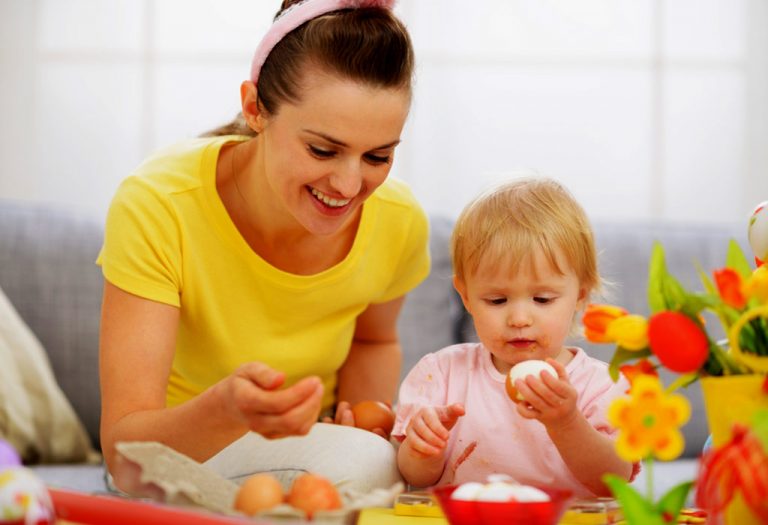Introducing Chicken to Babies – When, How & Recipes

Chicken is a versatile and nutritious option, offering a good source of protein, which serves as the primary building block in the body, crucial for growth and development. Its low-fat content further positions chicken as a healthy meat choice, especially when considering dietary additions for the entire family. When it comes to introducing solid foods to infants, many parents consider including chicken for baby due to its nutritional benefits. However, it’s essential to ensure that your baby is ready to embrace this new dietary adventure. A careful approach ensures that introducing chicken to your baby is both a safe and beneficial milestone in their dietary journey.
When Can Your Baby Eat Chicken?
Chicken should be added to a baby’s diet gradually, i.e., once he has started on solids. Once your baby turns six months of age, you can give him either finger foods or hand mashed purees. Once he completes six months of age, you can give him a chicken drumstick. It’s very important to go big at the beginning to prevent choking risks (1). Your baby will learn to navigate as he holds the drumstick and figures how to chew. You can also puree the chicken.
Nutritional Facts of Chicken
Chicken is, no doubt, packed with nutrients that can benefit your baby. Here is a table with the nutritional information of chicken. The table given below represents the nutrients present in 100 gms of uncooked chicken.
| Nutritional component | Nutrient value per 100 gram |
| Protein | 31 gm |
| Fats | 3.6 gm |
| Energy | 165 kcals |
| Vitamin A | 21 IU |
| Vitamin B1 | 0.1 mg |
| Vitamin B2 | 0.1 mg |
| Vitamin B3 | 13.7 mg |
| Vitamin B6 | 0.6 mg |
| Vitamin B12 | 0.3 mcg |
| Folate | 4 mcg |
| Vitamin C | 0 |
| Vitamin D | 0 |
| Vitamin E | 0.3 mg |
| Vitamin K | 0.3 mcg |
| Pantothenic acid | 1 mg |
| Calcium | 15 mg |
| Iron | 1 mg |
| Sodium | 74 mg |
| Phosphorous | 228 mg |
| Potassium | 256 mg |
| Magnesium | 29 mg |
| Zinc | 1 mg |
| Selenium | 27.6 mcg |
Amazing Health Benefits of Chicken for Babies
The various nutrients present in chicken offer the following health benefits to a baby.
1. Muscle Growth
Chicken is a rich source of protein which is essential to promote the growth of muscles of the baby (2). It is also found that proteins from animal sources are easily digested by the body when compared to plant proteins.
2. Enhances the Circulatory System
The iron content in chicken aids the production of red blood cells in the body. Chicken also has potassium which can keep the blood vessels in the body healthy.
3. Boosts Immunity
Chicken has micronutrients like zinc and magnesium which can build immunity in your baby and prevent infections and ailments.
4. Supports Brain Development
Rich in various B vitamins, particularly B12, chicken plays a crucial role in the development of the baby’s brain and nervous system (3). The presence of these nutrients helps in improving cognitive functions and can contribute to better concentration and memory as the baby grows.
5. Bone Health
Chicken is a good source of phosphorus, a mineral that is essential for the formation and maintenance of strong bones and teeth. This is particularly important in the early years of a baby’s growth, ensuring a solid foundation for skeletal health that can aid in preventing issues like osteoporosis later in life.
How You Should Select and Store Chicken?
When it comes to incorporating chicken into your diet, selecting and storing it properly is paramount to ensure its freshness, taste, and nutritional value. The process of choosing the right chicken and maintaining its quality until consumption can significantly impact your culinary experiences and health benefits derived from this versatile protein source.
Select Chicken
To ensure you’re selecting the highest quality chicken, start by examining its appearance and packaging. Look for chicken that has a pinkish hue without any signs of graying, which indicates freshness. The meat should feel firm and not sticky or slimy to the touch. Additionally, ensure the packaging is intact without any tears or leaks, as exposure to air can spoil the chicken. Opt for organic or free-range chicken if your budget allows, as these options tend to have better living conditions and diets, potentially leading to superior taste and nutritional content.
Store Chicken
Proper storage of chicken is crucial to prevent spoilage and foodborne illnesses. Fresh chicken should be stored in the refrigerator immediately after purchase and consumed within 1-2 days. If you need to store it for longer, freezing is the best option. Chicken can be kept in the freezer for up to nine months when stored correctly. To freeze chicken, remove it from its store packaging, wrap it tightly in plastic wrap, and then put it in foil to prevent freezer burn. When ready to use, thaw it in the refrigerator overnight rather than at room temperature to minimize the risk of bacterial growth. Always cook chicken thoroughly to an internal temperature of 165°F (74°C) to ensure safety.
Best Ways to Cook Chicken for Your Baby
If you want to start giving your baby chicken, you will need to know the best ways to do that. Here are some recommended ways to introduce chicken to your baby’s diet.
- Bake the chicken at 190 degree Celsius for 20 minutes. You will need to cut them into small, even piece before you bake it. Once baked, you can puree it for babies or shred it for kids over 12 months of age.
- Cut the chicken into thin slices and poach it. You will need to add just enough water in a saucepan to submerge the chicken. Boil this for about 20 minutes or until the chicken is completely cooked. You can strain the water and use it for some other dish or puree the chicken along with the water and give it to your baby.
- Boil small pieces of chicken in a saucepan with enough water to submerge it completely. You will need to boil it for 30 minutes or more and puree it. This is the best way of cooking chicken as it kills pathogens and softens the chicken meat.
Can Babies Be Allergic to Chicken?
When introducing any new foods to your baby you need to be cautious about the possibility of allergic reactions. Always introduce your baby one food at a time. If he shows any adverse reaction, immediately consult a doctor.
Babies with a sensitive digestive system and immune system have a risk of developing reactions to chicken. Although cooking can reduce the allergens in the baby, you should always look out for the signs of an allergy. Symptoms of an allergy can be:
- Swelling: Swollen face, neck, eyelids, throat, and nose indicate an allergy. Your baby may also find it difficult to open his eyes or breathe.
- Pain in the abdomen: Abdominal cramping or pain along with diarrhoea and vomiting.
- Rashes or hives on the skin: Itchy red bumps on the body.
- Fatigue: Weakness and dullness in the baby.
Should You Add Salt to Your Baby’s Chicken Soup?
Making chicken for baby is easy. Just do not add any salt when you make chicken soup for infants. It is also best to not salt to any food that you give to your baby when he is still younger than a year. This will allow him to experience and grow the like the natural taste of foods without any add-ons.
How to Cut and Serve Chicken to Baby-Led Weaning?
As babies grow, their ability to handle different food sizes and textures changes, so it’s important to adjust how you cut and serve chicken to match their developmental stages. Here’s how to safely introduce chicken to your baby from 6 to 12 months of age, ensuring they can enjoy and manage it as they learn to chew and swallow more effectively.
6 to 8 Months
At this stage, babies are just starting to get the hang of grasping objects. It’s essential to cut the chicken into long, finger-sized strips or shreds. These shapes are easy for them to pick up and suck on, even with their unrefined motor skills. Cook the chicken until it’s very tender, almost falling apart, to reduce the risk of choking. Boiling or slow cooking can achieve this texture. Remember, the goal is more about exploration and experiencing textures than actual consumption at this age.
8 to 10 Months
As babies develop a better pincer grasp (using the thumb and forefinger to pick things up), they can handle smaller pieces of food. Cut the chicken into bite-sized chunks, ensuring the pieces are still soft and easily squishable between your fingers. These smaller pieces encourage babies to start using their developing fine motor skills for self-feeding, promoting independence and dexterity. Lightly shredding chicken is also a good option, as it can be easier for babies to manage and less of a choking hazard.
10 to 12 Months
By now, most babies are proficient with the pincer grasp and may have even begun to master chewing motions. You can introduce more texture at this stage, offering pieces of chicken that are a bit larger and chunkier. Ensure the chicken is still tender but can be cut into cubes or strips that they can bite chunks off of. This not only helps with their chewing skills but also prepares them for a wider variety of food textures and types. Encouraging self-feeding with utensils can also begin at this stage, using fork-tender pieces of chicken that they can easily spear.
Some Safety Tips for Serving Chicken to Your Baby
When introducing chicken to your little one, here are a few safety tips that you can follow to avoid any complications that can come along with inadequate handling and storage of the chicken. So here’s how to how to serve chicken to baby safely.
- Buy organic chicken and if you’re buying a whole chicken, ensure that it is plump. The chicken should be very bony. If you are purchasing non-organic chicken, beware of chicken that has been injected with hormones to be plumped unnaturally.
- Buy chicken with opaque skin, and not the one with spots on it.
- When you’re buying frozen chicken, keep an eye out for any frozen liquid in the package. Avoid buying frozen chicken with frozen liquid, as this could mean that the chicken was thawed and frozen again, which essentially makes it unsafe to eat.
- Do not keep the fresh chicken in the refrigerator for more than two days.
- Thaw frozen chicken in the refrigerator. Unless you want to cook the chicken right away. Do not thaw it in the microwave. This is because the chicken may begin cooking on the inside, and if left aside for later, it may cultivate bacteria.
- Keep chicken away from other food items when preparing it to avoid any cross-contamination. Ensure that you wash your hands, the cutting board, and the utensils after cutting the chicken.
- You can check if the chicken is done by inserting a skewer into the thickest part of it. If you see clear juice running, instead of pink juice, the chicken is done. You may also want to take the extra precaution of using a meat thermometer. The internal temperature of a whole chicken should be 82.2 degree Celsius. Chicken with bone should have an internal temperature of 76.6 degree Celsius. Boneless chicken should have an internal temperature of 71.1 degree Celsius.
Healthy Chicken Recipes for Babies
Here are some delicious baby chicken recipes that you can try for your baby. These infant chicken recipes can be prepared quickly.
1. Chicken Puree
This basic chicken puree recipe for baby is the best way to introduce chicken to your little one.
Ideal age : 6+ Months
What you require
- 2 cups of boneless chicken, chopped
- Water
How to prepare
- Boil or pressure cook the chicken until it is tender.
- Cool the chicken and hand mash it.
- If you’ve roasted or poached the chicken, you may have to cut the chicken into smaller pieces to make it easier for blending.
2. Chicken and Sweet Potato Puree
Rich in vitamins and minerals, both sweet potatoes and chicken can be a great addition to your baby’s diet.
Ideal age : 6+ Months
What you require
- 2 cups of chopped sweet potatoes
- 2 cups of boneless chicken, chopped
- Water
How to prepare
- Cook the chicken and sweet potatoes separately until they are tender.
- Hand mash these ingredients.
3. Chicken Stew
If you want to wait a little longer to introduce proper solids to your baby but would like him to get the nutrients of chicken, chicken stew is a great option.
Ideal age : 9+ Months
What you require
- 1 cup chicken with bone
- Water
How to prepare
- Boil or pressure cook the chicken for 30 minutes to allow the nutrients of the chicken to seep into the water.
- Let the stew cool and strain it before serving it to your baby.
4. Apples and Chicken Puree
This recipe is simple, nutritious, and delicious.
Ideal age : 6+ Months
What you require
- ¼ cup chicken, boneless
- ¼ cup apples without seeds or homemade applesauce
How to prepare
- Cook the chicken and the apple separately until they are tender.
- Puree both the ingredients to achieve the required consistency.
5. Chicken, Rice, and Peach Puree
This is another chicken with fruit combination which babies will love to eat.
Ideal age : 6+ Months
What you require
- ½ cup chicken, boneless
- 2 cups of cooked rice (white or brown)
- 1 ripe peach
- 1 tablespoon breast milk or formula
How to prepare
- Cook the chicken and rice separately.
- Peel the peach and remove the pit.
- Hand mash the peach, milk, rice, and chicken to the required consistency.
6. Chicken and Carrot Puree
A smooth and nutritious blend of tender chicken and sweet carrots, perfect for babies exploring their first tastes of solid food.
Ideal age : 6+ Months
What you require
- ½ cup of boneless chicken, chopped
- 1 cup of carrots, peeled and chopped
- Water
How to prepare
- Cook the chicken and carrots separately until tender.
- Hand mash them together, adding a little water if necessary to get a smooth consistency.
7. Chicken and Avocado Puree
Creamy avocado and soft, cooked chicken come together in this wholesome pureed chicken for baby recipe, offering a heart-healthy fat and protein-packed meal for your little one.
Ideal age : 6+ Months
What you require
- ½ cup of cooked boneless chicken, chopped
- 1 ripe avocado
How to prepare
- Cook the chicken until it is tender.
- Mash the avocado with a fork until it’s smooth.
- Combine the chicken and avocado, pureeing until smooth. If needed, add a little water to adjust the consistency.
FAQs
1. What are the signs my baby is ready for chicken?
Signs that your baby is ready for solid foods, including chicken, include being able to sit up with minimal support, showing good neck and head control, displaying curiosity about what you’re eating, and the diminishing tongue-thrust reflex (which causes babies to push solids out of their mouths with their tongues).
2. How do I know if my baby is allergic to chicken?
Allergic reactions to chicken in babies are rare but can occur. Symptoms of a food allergy can include hives, itching or skin rash, swelling of the lips, face, or other body parts, gastrointestinal discomforts like vomiting or diarrhoea, and, in severe cases, difficulty breathing. If you notice any signs of an allergic reaction after introducing chicken, contact your pediatrician immediately. To minimize the risk, introduce chicken (and any new food) on its own and wait 3-5 days before introducing another new food. This waiting period makes it easier to identify the cause of any potential allergic reaction.
3. Can I offer seasoned chicken to my baby?
As your baby becomes more accustomed to chicken and solid foods in general, you can introduce mild seasonings. However, avoid adding salt, sugar, or strong spices initially. Herbs and mild spices like cinnamon or basil can be introduced gradually to enhance the flavor of the chicken and help develop your baby’s palate. Always ensure any added ingredients do not pose an allergy risk and are suitable for your baby’s age and developmental stage.
This was all about how to cook chicken for babies and some handy BLW chicken recipes. Ensure that you add chicken to your little one’s diet with proper caution. Always discuss with your baby’s doctor about the right time, quantity, and the best way to introduce it to your child.
References/Resources:
1. Hoffman. J, Falvo. M; Protein – Which is Best? (Journal of Sports Science & Medicine); National Library of Medicine; https://www.ncbi.nlm.nih.gov/pmc/articles/PMC3905294/; September 2004
2. Black. M; Effects of vitamin B12 and folate deficiency on brain development in children (Food and Nutrition Bulletin); National Library of Medicine; https://www.ncbi.nlm.nih.gov/pmc/articles/PMC3137939/; June 2008
3. Feeding Your Baby: The First Year; Cleveland Clinic; https://my.clevelandclinic.org/health/articles/9693-feeding-your-baby-the-first-year
4. Chicken, broiler or fryers, breast, skinless, boneless, meat only, raw; Food Data Central; U.S. Department of Agriculture; https://fdc.nal.usda.gov/fdc-app.html#/food-details/171077/nutrients
5. Chicken and Food Poisoning; Centers for Disease Control and Prevention; https://www.cdc.gov/foodsafety/chicken.html
6. Other Food Allergens; Food Allergy Research & Education; https://www.foodallergy.org/living-food-allergies/food-allergy-essentials/common-allergens/other-food-allergens
Also Read:
Salmon for Infant
Giving Fish to Babies
Benefits of Tuna for Babies
Was This Article Helpful?
Parenting is a huge responsibility, for you as a caregiver, but also for us as a parenting content platform. We understand that and take our responsibility of creating credible content seriously. FirstCry Parenting articles are written and published only after extensive research using factually sound references to deliver quality content that is accurate, validated by experts, and completely reliable. To understand how we go about creating content that is credible, read our editorial policy here.






